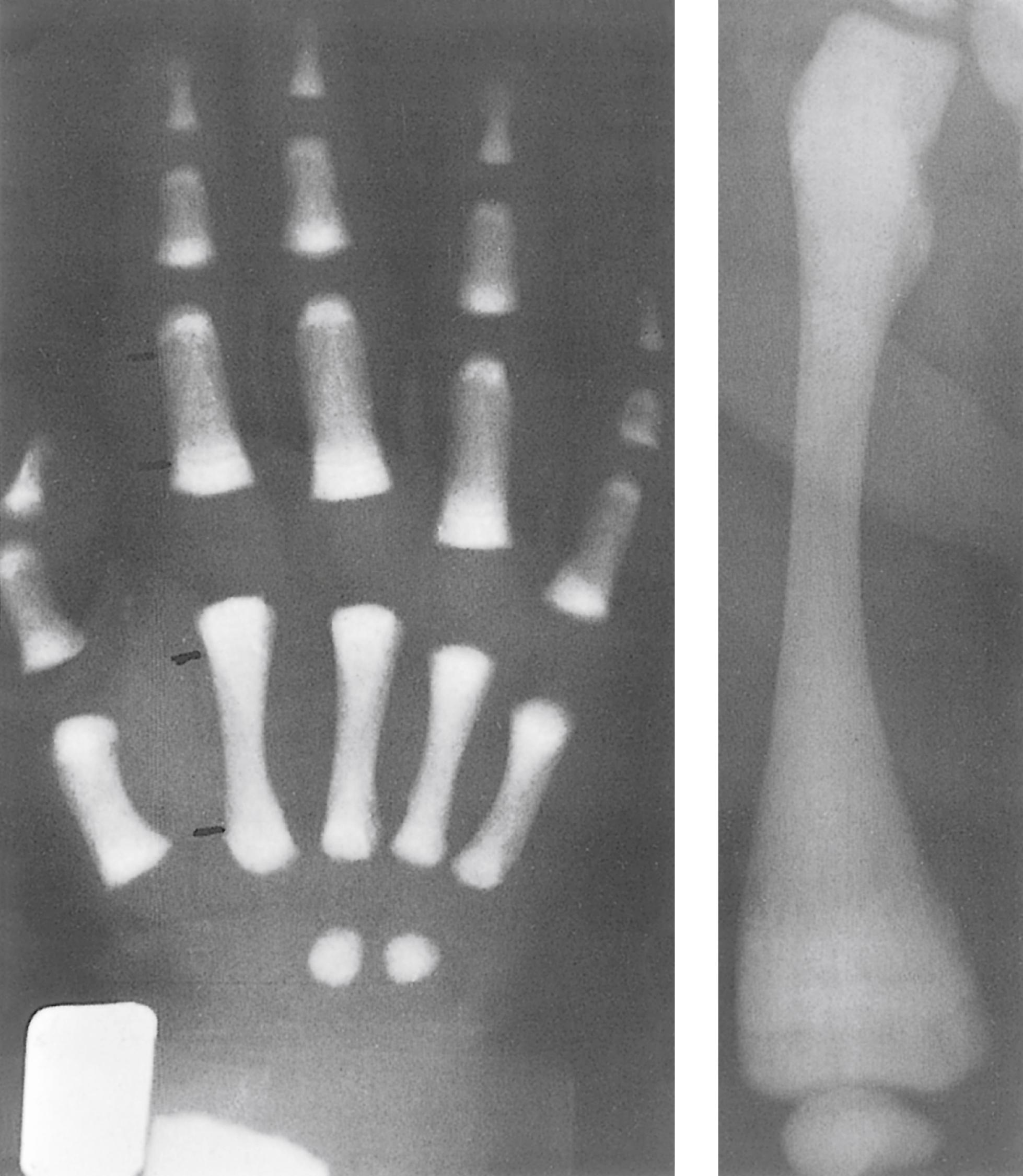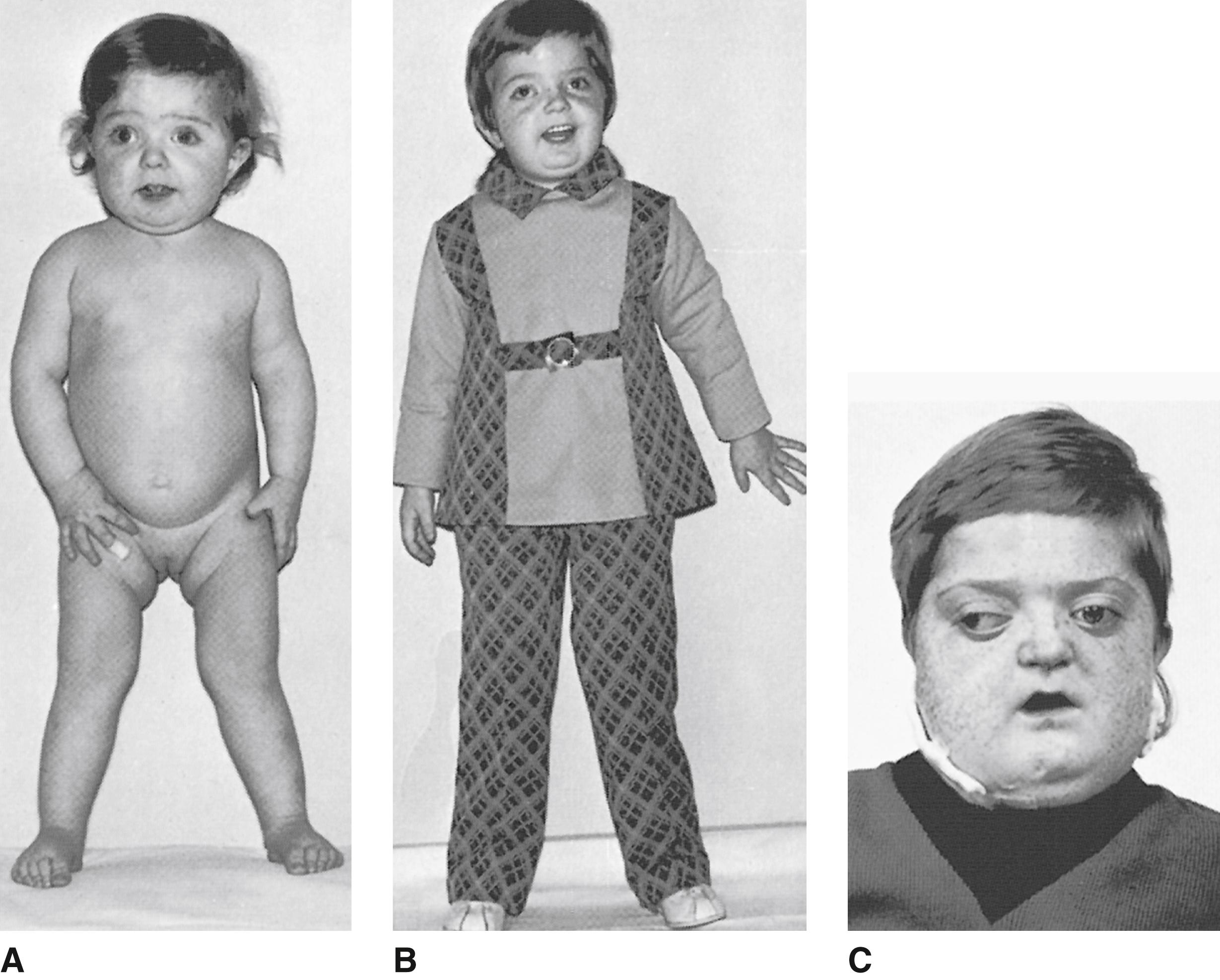Physical Address
304 North Cardinal St.
Dorchester Center, MA 02124
More than 100 cases of this genetically heterogeneous and commonly lethal group of disorders have been reported since the first cases were described. Two different subsets of patients are recognized based on bone morphology: (1) osteoclast-rich, associated with a high number of mature but nonfunctional osteoclasts; and (2) osteoclast-poor, in which these cells are absent because of a defect in differentiation. In both cases there is absence of proper bone resorption and an increased bone mass. It is estimated to occur in 1 of 250,000 births. Several genotypes of autosomal recessive osteopetrosis (ARO) have specific natural histories.
Growth. Normal birth parameters with subsequent failure to thrive and progressive macrocephaly. Short stature in untreated survivors.
Performance. Seizures secondary to hypocalcemia, blindness, hearing loss, intellectual disability (depends on genotype).
Craniofacial. Frontal bossing; open fontanel; progressive proptosis; strabismus; choanal stenosis; facial palsy; a tendency for primary molars and permanent dentition to be distorted and for teeth to fail to erupt; poor periodontal attachment, allowing for exfoliation; early decay.
Imaging. Thick, dense, fragile bone with modeling alterations such as obtuse mandibular angle, partial aplasia of distal phalanges, straight femora, block-like “bone within a bone” metacarpals, obliteration of bone marrow space.
Metabolic. Serum calcium level may be low and serum phosphorus level elevated, increased alkaline phosphatase.
Other. Hepatosplenomegaly secondary to extramedullary hematopoiesis; immunodeficiency.
Marrow impingement leads to pancytopenia. Compression of cranial foramina may lead to deafness, blindness, vestibular nerve dysfunction, extraocular muscle paralysis, other cranial nerve palsies, and hydrocephalus. Fractures are common. Ocular involvement, occurring at a median age of 2 months, is the most common presenting sign followed by seizures from hypocalcemia. Failure to thrive secondary to airway compromise occurs. Without treatment, life expectancy rarely exceeds adolescence for most forms. Problems with dentition and dental infection may include recurrent mandibular osteomyelitis.
This disorder has primarily an autosomal recessive inheritance pattern.
TCIRG1 mutations account for 50% of cases and present with a classic phenotype and a predominantly hematologic presentation. Neurologic issues are the result of compression of neural foramina rather than primary brain involvement. Hematopoietic stem cell transplant (HSCT) is effective. Founder mutations in Costa Rica make this form of ARO more common in this population.
CLCN7 mutations account for 15% of cases. Patients who are homozygous or compound heterozygous have a classic hematologic presentation; however, this mutation may cause severe primary involvement of the nervous system, specifically the brain and retina, which may not be mitigated by HSCT. Long-term survival without HSCT has been reported. Heterozygous mutations in this gene cause a spectrum of anomalies from bone sclerosis, fractures, and dental abscesses to asymptomatic increased bone mass. This gene is responsible for Albers-Schönberg disease.
OSTM1 mutations account for 5% of cases and include ARO associated with a lysosomal storage disorder and a particularly poor prognosis owing to severe brain anomalies and seizures. This condition is analogous to the gray-lethal phenotype in mice. HSCT has not been recommended in these patients.
PLEKHM1 mutations are rare (<1%), but they produce an ARO phenotype associated with much milder bone disease such that affected individuals have not needed HSCT.
Carbonic anhydrase II-dependent ARO is distinguished by its association with renal tubular acidosis and cerebral calcifications. HSCT is a therapeutic option.
NEMO -dependent osteopetrosis is rare, X-linked, and distinguished by the occurrence of lymphedema, immunodeficiency, and anhidrotic ectodermal dysplasia in affected males. HSCT is a therapeutic option.
SNX10 mutations, thus far reported only in the Palestinian population, cause a classic ARO that is ameliorated by HSCT. Mutations in this gene result in small osteoclasts with reduced reabsorptive capacity.
TNFSF11 (RANKL ) encodes the main osteoclast-differentiating factor produced by osteoblasts and stromal cells. Homozygous mutations in this gene cause a classic phenotype that is not rescued by HSCT because RANKL is not produced by hematopoietic lineages. Mutations in this gene account for 5% of cases.
TNFRSF11A (RANK) encodes the receptor for RANKL. Mutations in this gene account for 5% of ARO cases. Affected individuals have a severe skeletal phenotype with a milder hematologic presentation. It is recommended that this group be considered for HSCT early on the basis of severe skeletal rather than hematologic involvement. Affected individuals may have severe, prolonged hypercalcemia following transplantation.


Become a Clinical Tree membership for Full access and enjoy Unlimited articles
If you are a member. Log in here